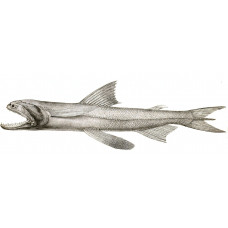Latin name
Harpadon nehereus
Other names
Bummalo, bombil, bombili, boomla, lote, loitta.
Identification
The body is pronghorn, compressed from the sides, without scales in the front part, soft to the touch. The external appearance of this fish is characterized by a rounded anterior profile of the head, a huge mouth with numerous small teeth bent backward.
Features of fish fins
Have long pectoral and pelvic fins and an unusual caudal fin that has a small third lobe in the middle, in the notch between the upper and lower lobes. Dorsal rays (total): 0; Dorsal soft rays (total): 11-13; Anal spines: 0; Anal soft rays: 13-15.
Fish colouring
The head, back and sides are translucent, light gray, with numerous star-shaped black or brown spots. The belly is pale, silvery-blue. The fins are translucent, the same color as the body, but the spots on them are more densely arranged, making them appear darker.
Distribution
Widespread in the coastal waters of the Indian and western Pacific Oceans.
Habitat
Marine brackish benthic benthopelagic oceanodromous tropical species. Occurs mainly in premarine areas of the sea, in estuaries.
Size
Adults can reach a maximum length of 40 centimeters (16 inches), but the common size is about 25 centimeters (10 inches).
Behavior
During certain seasons, this fish appears in schools near the shore and even enters freshwater estuaries, but it is believed to spend much of its life in the depths of the slope.
Food and feeding habits
They gather in large flocks in river deltas to feed during the monsoon. They are aggressive predators.
Reproduction
Produces 6 broods per year.
Fishing
This species is an important coastal fishery almost throughout its range, but its commercial importance is particularly high in the Ganges delta and off the west coast of India, in the waters of the state of Bombay.
Relationship with a person
The fish is extremely fatty and is stocked mainly in dried form, and on the west coast of India it is dried without prior salting and is known as Bombay duck.
| Classification | |
| Phylum | Chordata |
| Class | Actinopterygii |
| Squad | Aulopiformes |
| Family | Synodontidae |
| Genus | Harpadon |
| Species | H. nehereus |
| Features | |
| Conservation status | Near Threatened |
| Habitat | Pelagic |
| Life span, years | No information |
| Maximum body weight, kg | No information |
| Maximum length, cm | 40 |
| Sailing speed, m/s | No information |
| Threat to people | Edible |
| Way of eating | Predator |
Bombay duck
Tags: bombay duck


